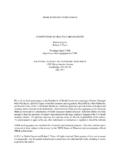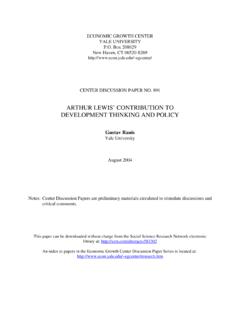Transcription of Industrial Growth and Competition
1 Industrial Growth and CompetitionK. Simons, 20031 Essential Course NotesEC2212 Industrial Growth andCompetitionThe Role of Technology in Firm Success, IndustryEvolution, and Regional and National GrowthKenneth L. SimonsDate of this version: 12 Jan. of first version: Autumn 1996-2003 by Kenneth L. Rights Growth and CompetitionK. Simons, for The and , Assignments, and Due and Quick Reference to 1. Technological Change and Economic 2. Sources of Invention Small Firms and Innovative 3. Sources of Improvement and Efficiency Big Firms and 4. Evolution of New 5. Turnover of Corporate 6. 7. Alternative Reasons for Shakeouts and Industry 8. Product Differentiation and Market 9. Firm 10. Firm Technological Success and National Growth & Technological Change and Economic Technology Contributes Enormously to Economic Growth and Technology: Some Unbound Schumpeter and the Schumpeterian Industry and Technological Basic Model of Economic Sources of Invention: Small Firms and Innovative who Create Agglomerations of Economy of Growth and CompetitionK.
2 Simons, 200335. Sources of Invention: Big Firms & Streamlined Structure, Improvement & Size and R& Findings about Firm Size, Industry Concentration, and R& Cost-Spreading A Model that Explains the Empirical Evolution of New of Competitive First Comparison of Some Industry Evolutionary Turnover of Corporate and Analyzing Corporate Leadership Does Leadership Turnover Occur?..70 Does Leadership Turnover Occur?..71 Possible Firm and Non-Technological Causes of Theory of Survival of Evidence Regarding the and Non-Technological Causes of Alternative Reasons for Shakeouts and Industry for Advantages to Large Firms / Early Assumptions Affect Conclusions in Models of Industry on Predicted Industry Product Differentiation and Market Product Differentiation Matters for Competition and Industry Analyses.
3 101 Market Niches of Product Differentiation and its Firm Myth of the U-Shaped Long-Run Firm Cost Theories of Firm Patterns in Product Patterns for Firms/Plants in Multiple Firm Technological Success and National versus Leapfrog Models of Technology Up in the Face of International Growth and CompetitionK. Simons, 20034 National Technology Mathematical Skills Related to the a Course and Extended References in the Main Bibliography - How Industries Entry and Survival - Age and Size Entry and Survival - Organizational Ecology Entry and Survival - Patterns of Leadership Entry and Survival - Patterns of - - - Inter-Firm - Labor - Vertical Agglomeration of Firms and R& of Industry and Technology (Key Works)..146 Industry Economics Cost - Cost Curves and Minimum Efficient Production Cost - Experience/Learning Curves, Progressive - - Incentive - Racing and Preemptive - Sources of - Demand-Pull versus - Diffusion / - Dominant - Lock-In and Network - Product Life - Schumpeterian - Growth and CompetitionK.
4 Simons, 20035 TablesTable Growth Rates (% per year) of GDP per Worker Hour in Sixteen IndustrialCountries, Examples of Corporate Leadership Turnover in the US ..69 Table Degree of Shakeout in a Sample of US Manufactured Penicillin Types and Their Manufacturers, Evolving Size Distribution in US Tire Evolving Size Distribution in US Tire Manufacturing, 4A Firms in 1930 ..111 Table Evolving Size Distribution in US Tire Manufacturing, B Firms in 1915 ..112 Table Growth and Exit among US Manufacturing Production over Time in Growth Model with No Productivity Production over Time in Growth Model with 3% Annual Productivity Number of Manufacturers versus Time of Various US and UK Number of Producers, Entry, and Exit in the Four Price and Output in the Four One Theory (that Seems to Fit with Facts) About Survival over Time in the Four Survival in Manufacture of Ballpoint Survival in Manufacture of Illustration of Sutton s Model of Effects of Advertising U-Shaped Marginal and Average Cost U-Shaped Cost of Firm positions and profits in quality-efficiency International and home-country producers in quality-efficiency Growth and CompetitionK.
5 Simons, 20036 Syllabus forEC2212 Industrial Growth and CompetitionK. Simons, 200371. The CourseThe Growth of economies depends on the Growth and survival of industries andfirms. If you analyze national or multinational economies, industry Competition , orcompany management, it is important to know how industries develop and change. Acrucial part of this change, in many industries and for overall economic Growth , iscontinual development of new or improved production methods and course examines Industrial change beginning from the inception of anindustry. We pay close attention to technology, which often drives industrialcompetition. We examine the entry, exit, and Growth of firms in individual markets, suchas the production of automobiles, shampoo, calculators, penicillin, or software.
6 We studyhow oligopolies form. We talk about possible national policies and strategies forcorporate success. Parts of the story include product variety, economies of scale andscope, advertising and distribution, firm Growth by expansion or merger, internationaltrade, and the Growth of these issues in practice requires considerable research skills, and thecourse is designed to give you some of those skills. Half your grade in the course willcome from a research project. You will learn ways to collect data, analyze it, and relateyour findings to topics in the course. Your experience in the project is useful preparationfor third-year dissertations, and also for industry studies carried out in financial firms,consultancies, and corporate is a half-unit course for second- or third-year economics prerequisites are quantitative methods I and principles of with other backgrounds should consult the lecturer before registering.
7 As usualfor courses at Royal Holloway, Industrial Growth and Competition should take you aboutten hours per week. Your grade is based 50% on the research project, and 50% on anend-of-year ObjectivesIn this course, you will learn: Ways in which firms change and compete in industries, with a focus on ways relatedto technological change. Also, ways in which the industries relate to regional,national, and global economic Growth . Skills useful for research in which you analyze actual firms, markets, or following is an approximate schedule, divided into ten weeks:1. Technological Change and Economic Growth2. Sources of Invention: Small Firms and Innovative Networks3. Sources of Improvement and Efficiency: Big Firms and Streamlined Structure4. Evolution of New Industries5. Turnover of Corporate Leadership6.
8 Shakeouts7. Sources of Increasing ReturnsIndustrial Growth and CompetitionK. Simons, 200388. Product Niches, Patents, Economies of Production Scale, & Other Influences onDynamics9. Firm Growth10. Supporting Economic GrowthLectures and SeminarsLectures are for all students simultaneously, and mainly provide a first-passopportunity to learn the material in the lecture notes. Feel free to ask questions;sometimes you will be asked questions too. Seminars involve fewer students at a time soit is easier to discuss course material and practice with it, and discuss how to handle yourongoing projects. Attendance will be taken at seminars and if you fail to attend morethan one seminar, expect to be questioned by your advisor and/or by the department sacademic coordinator; in extreme cases students may even be barred from exams for non-attendance!
9 (These attendance policies hold for all courses in the department.) Beforeeach seminar, you absolutely must study all sections of the course notes that pertain tolectures given to date. We will discuss this material and you will be quizzed and put onthe spot to answer questions! Studying the course notes should not take long so thisshould not be a big burden; the other required readings (see below) may be done at anyappropriate time. Bring your course notes with you to the seminars. Seminars willinvolve many kinds of activities, including at one point a game that will help youexperience firsthand some of the industry theories in the , Assignments, and Due DatesYou choose, during the first seminar session, a research topic to analyze duringthe course. Every project will involve collection of some empirical evidence (orsimulated data in rare cases), statistical analysis of the evidence, and a write-up withreference to the relevant literature.
10 As the course goes along, I will guide you to gothrough these processes. You will be part of a team that gathers key information, butultimately you will do your own analyses and write your own report. You and your teamshould start reading and gathering relevant information right away. Biweeklyassignments will help you prepare the final project report, because each assignmentrequires you to do a key piece of the project the following due dates. Assignments are due in your seminar classes andwill be discussed but not be collected; you will tick a sheet indicating whether you havedone the assignment. Two copies of the final project report must be handed in to thedepartment office by noon on the last day of the spring 1 Team report: literature review about the team s topic11 2 Team report: data listing and documentation (datacollection required!)


















